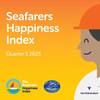Containership Design
Setting New Standards
Seaspan Saver, a 10,000 TEU container vessel is setting new standards in container ship design. MARIN and Marine Design and Research Institute of China (MARIC) developed the hull lines of this unique vessel, which has been entirely designed with a low operational cost profile in mind. Canadian owner Seaspan requested a hull form that facilitates very low fuel consumption in the operational speed range, but at the same time it had to be able to keep an acceptable top speed. This approach is in stark contrast to previous ideas, which have focused on having the highest possible top speed. With the current slow steaming trend and upcoming EEDI regulations this new approach is favorable. With the aid of extensive CFD calculations and close cooperation, a well-balanced container ship design was created.
However, it was undoubtedly a challenge to balance a low operational speed range and acceptable top speed, particularly whilst taking multiple operational draughts into account. By using fast potential flow calculations and even more accurate (but time consuming) RANS calculations, a very good hull was designed. MARIN used its experience of having optimized over 30 single screw container vessels with a length of more than 300 m, in combination with full-scale speed trials data from these very large container vessels at the normal ballast trial draught and, even more importantly, at design draught.
After the optimization of the hull lines a large ship model was manufactured. For large container vessels up to 20,000 TEU, hull models up to 13 m in length are used with propeller diameters close to 300mm. This avoids scale effects as much as possible. Following the initial model tests with a propeller from MARIN’s own stock – which contains several thousand propellers – a propeller was finally designed by Japan’s Nakashima and a twisted leading edge rudder design was made by the German company Becker Marine Systems. The final model tests showed that the propeller was highly efficient.
Cavitation was checked by high-speed video observations.
Patrick Hooijmans is project manager at the Ships department of MARIN, the Maritime Research Institute Netherlands.
Email: [email protected]
(As published in the November 2012 edition of Maritime Reporter - www.marinelink.com)















